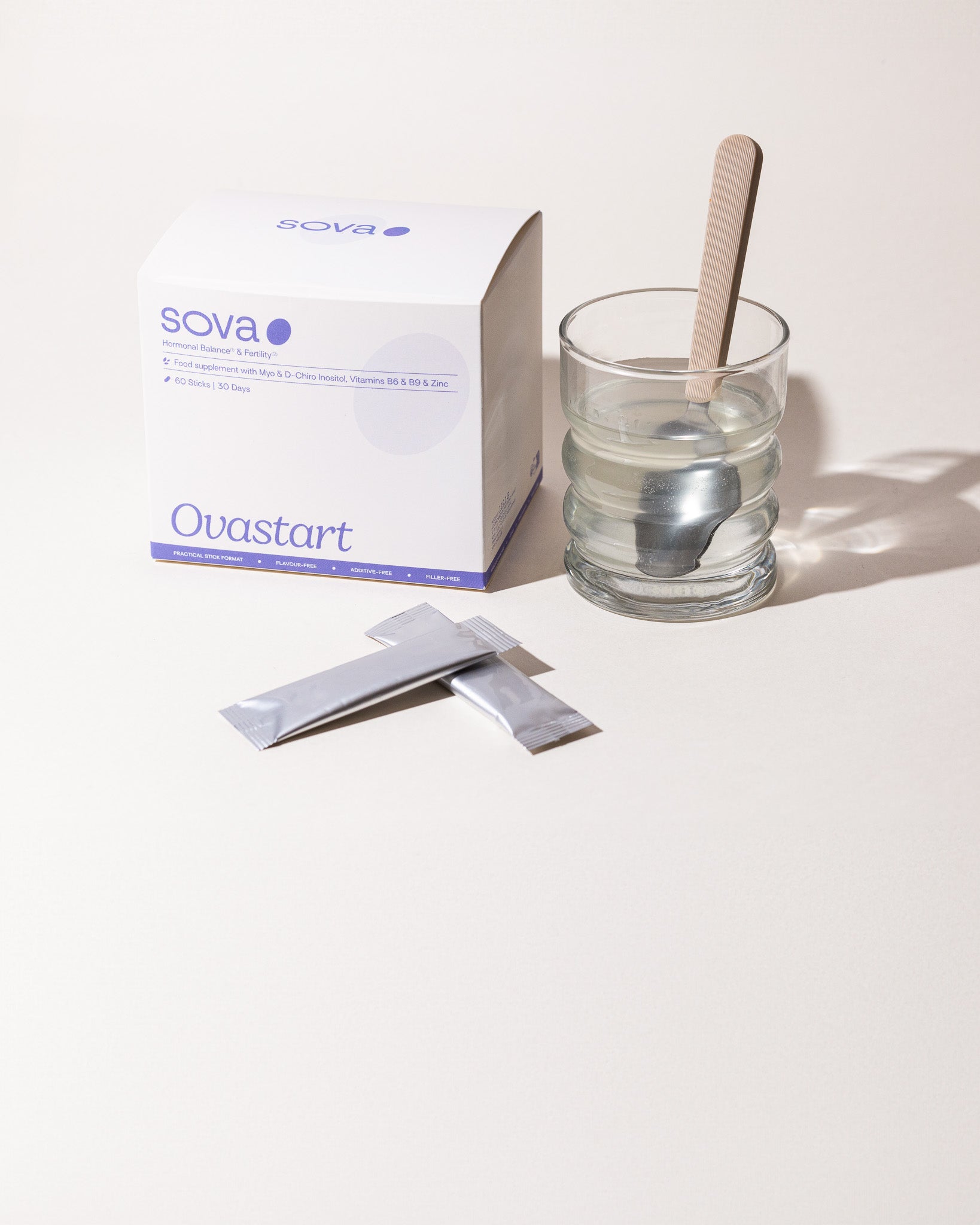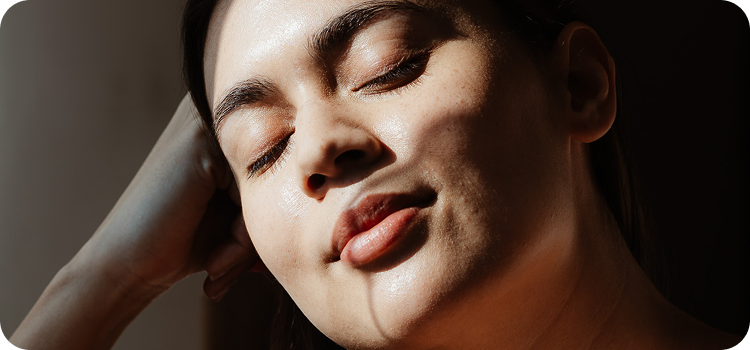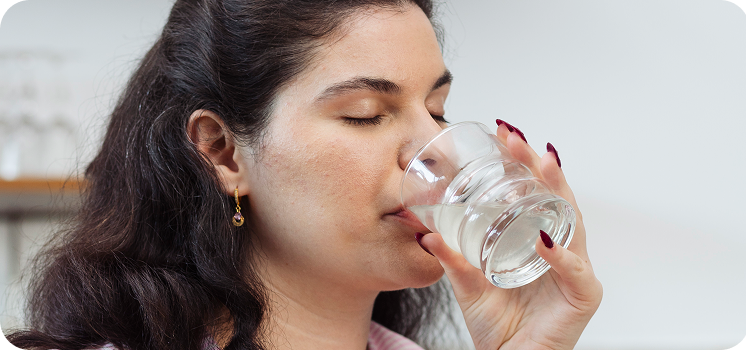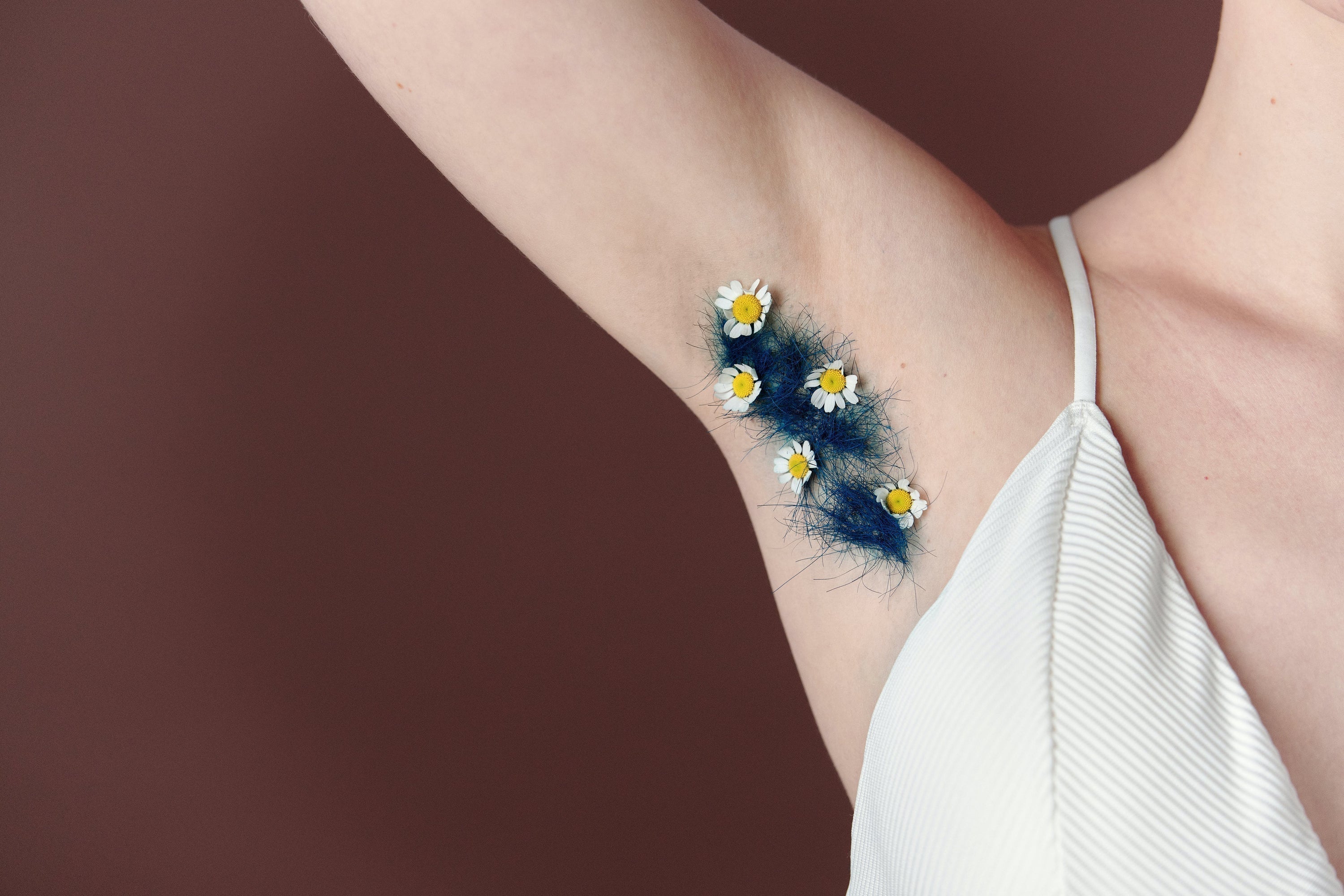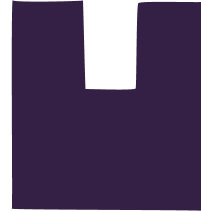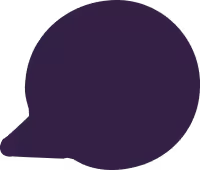Table of contents
Polycystic Ovary Syndrome (PCOS) is a common hormonal and metabolic disorder among women of reproductive age, affecting about 8 to 13% of women in the UK (and increasing in number).
One of the most visible and bothersome symptoms of PCOS is hirsutism, characterized by excessive hair growth on the face, chest, back, and other areas of the body. This hair growth often leads to insecurity, discomfort, and even social anxiety.
Don’t worry, you’re in the right place! In this article, we’ll explain the various medical and natural solutions to tackle this symptom, which, as we know, can be truly debilitating.
A brief overview of PCOS
Definition
Polycystic Ovary Syndrome (PCOS) is a global hormonal and metabolic disorder that primarily affects your reproductive system, metabolism, weight, and even your mental state (impact on stress and emotions management).
It is characterized by hormonal imbalance, blood sugar issues, and chronic inflammation that disrupt how your body processes sugars and fats, interferes with ovulation, and can notably impact your fertility (among other things). Women with PCOS typically have elevated levels of androgens (male hormones like testosterone), which can lead to a range of symptoms: menstrual irregularities (long cycles or absent periods), fertility issues, weight gain, excessive hair growth (hirsutism), acne, and changes in skin texture (sounds fun, right?).
Studies have shown that PCOS is one of the leading causes of infertility in women and requires appropriate management to control your symptoms and prevent long-term complications. But don’t worry, it is entirely possible to get pregnant with PCOS as many women with PCOS have conceived naturally or with medical assistance (ART).
👉 For more information on this topic, check out our article How to Get Pregnant with PCOS?
Among women with PCOS (like you perhaps!), about 60% experience abnormal hair growth known as hirsutism.
👉 To learn more about the health impact of PCOS, check out our comprehensive article on PCOS.
Hirsutism and PCOS
In this section, we’ll explain how PCOS affects hair growth and the possible links between your PCOS and hirsutism you may be experiencing.
Definition of Hirsutism
Hirsutism is a medical term used to describe a condition characterized by excessive unwanted hair growth, particularly in areas where hair is typically sparse, such as the face, chest, back, or abdomen. This excessive hair growth is often thicker and darker than normal hair.
Hirsutism is generally caused by a hormonal imbalance, particularly an increase in male hormones called androgens (such as testosterone, but not only!). It can be associated with medical conditions like PCOS and congenital adrenal hyperplasia (a hormonal disorder related to small glands above your kidneys, known as adrenal glands). Hirsutism can also be idiopathic, meaning it occurs without specific medical cause.
In some people, hirsutism can have significant psychological and aesthetic implications, affecting self-confidence and quality of life, but effective medical and cosmetic treatments are available to manage it, and we’ll explain them in the next section.
Impacts of Hirsutism on Your Quality of Life
Here at SOVA, we understand that hirsutism can affect your self-confidence, body image, and even your social interactions!
Often, hirsutism can impact how you perceive your body and your relationship with femininity.
You may feel anxious, depressed, and socially isolated due to fear of being judged by others.
You might even avoid social activities, romantic encounters, and professional interactions to escape the gaze of others.
The need to hide this unwanted hair using hair removal methods, makeup, and covering clothes can also be both restrictive and costly.
To help you better understand what’s happening in your body, let’s analyze together the causes of hirsutism in the context of PCOS.
Causes of Hirsutism in PCOS
Hirsutism is one of the hallmark symptoms of PCOS and is often caused by hormonal imbalance, particularly an increase in androgen levels (again, your male hormones including testosterone!). Here’s why you might develop hirsutism with PCOS:
- Excess Androgens: Androgens are male hormones, including testosterone, present in lower quantities in women than in men. However, women with PCOS tend to have high levels of androgens, which can stimulate excessive body hair growth, including in areas where women typically have less hair, such as the face, chest, and back. Hair growth depends on the balance between androgens (e.g., testosterone, DHEA, or DHT) and estrogens. When androgens are in excess, they promote the growth of thick, dark hair. Testosterone stimulates hair growth in the pubic and armpit regions while DHT stimulates facial hair growth (beard appearance) and hair loss on the scalp.
- Hyperinsulinemia: Women with PCOS often have insulin resistance, a disorder that can lead to increased insulin levels in the blood (insulin is the hormone that lowers blood sugar levels). This can stimulate the production of androgens by the ovaries and adrenal glands, contributing to hirsutism. Hyperinsulinemia is also often associated with metabolic disorders such as type 2 diabetes and obesity, two common conditions in women with PCOS. To learn more about insulin resistance, check out our article: Insulin Resistance and PCOS.
- Heredity: Family history can also play a role in the development of hirsutism in women with PCOS. If other family members have had similar symptoms, there might be a genetic component predisposing you to it.
- Follicle Response: Hair follicles (small pockets in your skin that hold your hair roots) in women with PCOS may be more sensitive to stimulation by androgens. This means that even low levels of androgens can trigger excessive hair growth, which is why you might have hirsutism even if you don’t have high androgen levels in your blood tests.
It’s important to note that hirsutism in PCOS can vary in intensity from one woman to another. Some may only have mild symptoms, while others may experience more severe hirsutism.
Managing hirsutism in the context of PCOS be done through various means: lifestyle changes, medication such as hormonal contraception, anti-androgens, or hair removal methods, depending on the symptoms and individual needs of each patient. It is recommended to consult a healthcare professional to determine the best treatment plan.
Natural Management of Hirsutism
First of all, it’s important for you to determine which type of PCOS you have to tailor a symptom management strategy closest to your needs.
👉 You can also read our article on this topic here: The Different Types of PCOS.
To recap, PCOS symptoms can be divided into four main categories, or "types", that represent key areas to work on to regulate your symptoms: inflammatory type, insulin-resistant type, adrenal type, and hypothyroid type.
In any case, we’ll explain in the following sections what you can do to naturally reduce your symptoms, particularly hirsutism.
Weight Management and Diet
Maintaining a healthy body weight can help reduce PCOS symptoms, including hirsutism. Regular exercise and a balanced diet can contribute to weight management.
A diet rich in fiber, low glycaemic index foods (to reduce blood sugar levels that can otherwise increase male hormones levels), and omega-3 fatty acids (to reduce inflammation) can all be beneficial for women with PCOS. These foods can help stabilize insulin and other hormone levels. By regulating your hormones, you can then see a reduction in unwanted hair growth.
👉 For more information on diet and weight loss with PCOS, you can check out our two articles: Nutrition and PCOS: The key rules of a diet adapted to your type of PCOS and How to Lose Weight with PCOS.
Supplements
Certain supplements such as inulin, zinc, plants like peony or licorice, and inositol can help reduce PCOS symptoms, particularly hirsutism.
Inositol is a molecule derived from glucose breakdown in our body, and appears in all our tissues, especially in the nervous system (in the brain), heart, and liver. It plays a role in carbohydrate and lipid metabolism (their transformation and elimination by the body), affecting affecting cholesterol, blood sugar levels, and blood pressure.
SOVA’s OVASTART supplement supports your hormonal and menstrual health and promotes regulation and balance throughout your cycle.
Many women with PCOS take Ovastart for at least 3 months and see improvements in symptoms like irregular cycles, acne and excess hair growth. Take our quiz to see if Ovastart is right for you.
Inulin is a natural fiber found in various plants such as chicory, agave, garlic, asparagus, artichoke, and Jerusalem artichoke. A study demonstrated the beneficial effects of inulin supplementation in reducing PCOS symptoms, particularly chronic inflammation.
As for zinc, it is a mineral naturally occurring in our diet, especially seafood (fish, crustaceans, shellfish) but also egg yolks and whole grains. Zinc actively contributes to hormonal balance and immune response regulation. Using 50 mg/day of zinc for 8 weeks in women with PCOS has shown beneficial effects on hair loss and hirsutism. It helps maintain normal blood testosterone levels , which is why OVASTART also includes it!
Peony and licorice are plants traditionally used in Chinese medicine, particularly to support liver function, but not just that! These two plants, when taken together, help reduce circulating testosterone levels in your blood, thereby reducing visible symptoms like acne, hirsutism, and hair loss.
Stress Management, Sleep, and Endocrine Disruptors
Managing your symptoms holistically starts with improving your daily lifestyle, especially stress and emotion management, improving sleep quality, and reducing exposure to endocrine disruptors.
Reducing stress can positively impact hormonal imbalance. Meditation, yoga, and other stress management techniques can help regulate stress hormones (particularly cortisol), which disrupt the production of female hormones.
Improving sleep quality is another way to regulate hormones: sleep disorders impact hormone balance and can worsen various PCOS symptoms, such as weight gain, blood sugar imbalance, sugar cravings, chronic fatigue, stress, and so on. PCOS may also directly affect your sleep because chronic pain and inflammation. Establishing a soothing bedtime routine, dietary changes, or supplementing with adaptogenic plants or magnesium are avenues to explore for better sleep and symptom relief.
Regarding PCOS and exposure to endocrine disruptors, more and more studies highlight the links between PCOS symptoms and exposure to substances known to disrupt hormonal balance. These substances, often from the petrochemical, textile, or food industries, can disrupt your hormonal system in three ways, once ingested or in contact with your body:
- altering natural hormone production;
- mimicking the action of these hormones by substituting for them;
- blocking the action of these hormones by attaching to the receptors they usually interact with.
Opting for natural cooking utensils (wood, glass, clay, or stainless steel), simplifying your skincare routine, and choosing second-hand clothes can help reduce endocrine disruptors in your daily life.
To better understand where these disruptors can be found in your home and how to reduce their presence, download our free ebook that will give you the 10 essential steps to naturally reduce your PCOS symptoms: Our Ebook - SOVA.
How to Remove or Slow Down Hair Growth?
When it comes to removing unwanted hair, you can either do it yourself at home, have it done in a salon, or choose more permanent methods requiring medical intervention.
Removing Hair at Home
Virgin tigernut oil is derived from cold-pressing the fruits of a rhizomatous plant. Tigernut oil is reputed for its observed effect on hair growth: it is said to slow regrowth! Though not widely studied, tigernut oil is reputed to slow down hair regrowth. Many users have observed that after repeated use, epilated hair becomes finer or even ceases to regrow altogether. It might be worth a try for you!
There are different hair removal methods. The most well-known method is, of course, shaving, which is quick, economical, and painless; it's a temporary solution to remove hair. However, regrowth tends to be swift, with hair often appearing thicker. Many women feel uncomfortable shaving their face, and long-term shaving can make the hair more noticeable.
The second method is waxing, which involves applying hot or cold wax to the skin, then pulling out the hair with strips or directly. The benefits are longer-lasting results(about two weeks) and slower regrowth.
But this method can be quite painful and may cause irritation and uneven regrowth that requires daily maintenance. The cost varies depending on whether you do it yourself or have it done at a beauty salon.
An alternative solution is to use an electric epilator, an electric device equipped with small tweezers to pull the hair out from the root. The advantage being you only buy the device once but using it regularly for several years. This method offers similar results and drawbacks to waxing.
You’ve probably seen TV ads for brands of depilatory creams promising wonders! These products involve applying a chemical cream that dissolves the hair, followed by removing it with a spatula. The pros are that they’re easy to use, fast-acting, and generally painless. However, the smell can be quite strong, and those with sensitive skin might want to avoid them altogether, as the ingredient list can be quite alarming.
Professional or Medical Methods
Let’s now turn to the more expensive and especially more permanent hair removal methods. We’ll guide you through them, to make the best choice for your particular needs!
Threading
Threading is becoming increasingly popular. What does it involve?
This technique comes from India and is also widely practiced in many Eastern countries, where it is used to remove hair from all areas of the body. Performed in beauty salons, the practitioner uses a twisted thread to pull hair from the root. Hair regrows slower compared to other methods like waxing or using an electric epilator.
This method is particularly recommended for people with sensitive skin as it leaves no marks (no redness, bumps, ingrown hairs, etc.). However, this technique is primarily used for facial hair as applying it to the rest of the body would make the process quite time-consuming.
Cost of threading varies according to the salon and the treated area, ranging from £5 to £25 per area.
IPL Hair Removal
Another option is Intense Pulsed Light (IPL) hair removal which can target either hair or red blood cell pigmentation , or even sunspots.
It involves using intense pulsed light to destroy the hair and its follicle (the root-holding pocket) using heat.
The light targets melanin (the substance that colors hair) in the hair follicle while minimising damage to the surrounding skin, thus reducing the risk of burns.
While commonly used in beauty salons for hair removal, it less effective than laser or electric hair removal. This technique yields better results on surface skin spots.
The cost of IPL treatment depends on the technique used and the treated area. Prices can go up to £200 per session in a medical setting.
IPL hair removal can be performed on anyone except pregnant or breastfeeding women, and adolescents.
Not all areas of the body respond the same way to this technique, and the number of sessions may vary depending on the treated area, hair growth extent, and its color and thickness.
The areas that respond best to treatment are the chin, upper lip (mustache), eyebrows, legs, thighs, armpits, and bikini line.
Be cautious, though: areas like the cheeks, jawline, and neck carry a risk of stimulating fine hair into thicker growth.
Furthermore, IPL does not work on white or blonde hair as these lack melanin, the pigment required for the laser to be effective. Darker, coloured and black skins require specific lights and settings to prevent damage.
You cannot undergo IPL if you are tanned, nor expose yourself to the sun in the weeks following your session, so it’s best to avoid it during the summer season!
The first two sessions will be spaced about 4 weeks apart, with the next ones spread out based on regrowth. You cannot remove hair yourself in between two sessions. Once the desired result is achieved, maintenance sessions of 1 to 2 times a year are recommended.
IPL also comes with some risks to your health: pain, erythema, burning sensation, and even delayed skin cancer diagnosis through cancerous lesion bleaching. Additionally, since this technique is generally not performed by medical professionals (dermatologists, aesthetics doctors), and the quality of devices can vary, we would recommend following the next two methods for permanent hair removal instead.
Electrolysis Hair Removal
Electrolysis Hair Removal (Electrolysis) is the oldest and most effective permanent hair removal technique. It works by destroying growing hair, regardless of pigmentation and involves inserting a fine wire into the hair follicle with low-voltage electric current then destroying the follicle. The hair is then removed with tweezers. This precision technique works one hair at a time, ensuring optimal, harmonious results.
It is important to note that electrolysis is suitable for all hair types and skin types, unlike other hair removal methods like laser.
Indications for electrolysis:
- Hair not responsive to laser (red, white, blonde, grey, or fine hair),
- Areas contraindicated for laser (e.g.,neck, cheeks),
- Final touch up after laser treatment,
- Correction of paradoxical hypertrichosis (unexpected hair growth after laser).
For optimal results, multiple electrolysis sessions are generally needed, as not all hair is in the growth phase at the same time. Treatment may take 12 to 18 months, depending on the area.
Note: new hair may still appear due to hormonal changes or medication. Occasional touch-ups may be required. Thereafter, an annual session is usually enough to maintain good results. Considering that it treats hair one at a time, this method may seem lengthy, but it’s the most effective for permanently eradicating hair.
In the weeks before your electrolysis session, avoid sun exposure and removing or bleaching your hair. Depending on the area to be treated, you may need to apply an anaesthetic numbing cream just before your session to minimise discomfort.
There are few contraindications. However, as a precaution, the following will not be treated:
- Pregnant women
- Pacemaker wearers or those with cardiac conduction disorders
- Patients on oral or topical acne treatment (tretinoin)
- Patients with evolving skin disease on the treated area
Sun exposure is prohibited right after the session.
The cost of permanent electrolysis hair removal is around £60 to £150 per hour (proportional to the time spent), depending on the location. Typically, sessions last about 20 minutes for the face or 2 hours for a larger body area (e.g., legs). During your first consultation, a personalised consultation will be carried out to assess the number of sessions needed.
It is vital to consult a qualified professional for electrolysis, such as a dermatologist or licensed electrologist, to ensure a safe and effective procedure.
This method is not generally reimbursed by the NHS but ask your dermatologist about possible options.
Laser Hair Removal
Like electrolysis, laser hair removal targets the roots, destroying hair follicles. The heat-producing laser destroys the follicles and, usually, the hair tends to not grow back.
This method can be done in a beauty salon or by a aesthetics doctors and dermatologists. We recommend seeking treatment from the latter medical specialists.
The number of sessions required depends on hair regrowth, the treated area and initial hair growth. The typical schedule is:
- 5 to 6 weeks between the first and second session (but it can be reduced to 3 weeks for hormone-sensitive areas such as the face),
- About 6 weeks between the second and third session,
- 2 to 3 months between subsequent sessions, depending on hair regrowth,
- Then maintenance sessions, if and when needed.
Your aesthetics doctor will determine the required number of sessions and frequency.
All areas can be treated with laser hair removal. However, better results are obtained on dark hair. Blonde or white hair does not respond well or at all as they lack pigment to attract laser light. If you have dark or tanned skin, additional precautions will be needed.
Contraindications: various treatments (antibiotics, corticosteroids, Roaccutane), skin diseases or lesions, infections or herpes are contraindications, as well as pregnancy, breastfeeding, or a tattoo on the treated area.
Similar to IPL, laser carries some health risks such as depigmentation, possible burns, skin infections, and even secondary hyperpigmentation risks (dark spots on the skin).
Cost of laser sessions starts at £40 to £60 for 10 to 15 minutes of hair removal but depend mainly on the treated area and time spent. We recommend consulting your practitioner for more information.
Despite being highly effective, laser can promote a phenomenon known as “paradoxical regrowth,” where fine hairs appear in untreated areas close to the treated ones.
Given that laser can stimulate hair regrowth, we encourage you to opt for electrolysis, which is the most recommended method for hirsutism with or without PCOS.
Treatments to Reduce Excessive Hair Growth
It is essential to consult healthcare professionals such as a gynaecologist, endocrinologist, and dermatologist when you have PCOS for several important reasons. First of all, PCOS is a complex disorder that significantly affects your reproductive health and overall well-being. These specialists are trained to diagnose and effectively treat your symptoms.
Remember, while there’s no cure for PCOS, patient comfort can be improved through symptom management, and it’s entirely possible to live well with the condition. PCOS treatment is purely symptomatic and lasts until menopause. It involves improving lifestyle, medication, and psychological support when needed.
Effective Management Tips
Managing hirsutism often benefits from an integrated approach combining natural and medical methods. Natural approaches, such as adopting a balanced diet, stress management, and incorporating beneficial herbs, can play a crucial role in hormonal regulation and reducing overall symptom burden, including hair growth.
However, it is equally important to work closely with healthcare professionals to both explore specific medical options such as hormonal treatments, and address underlying imbalances. This combined approach offers a holistic method, treating physiological aspects while considering emotional well-being. Together, we create a synergy that can provide more complete and lasting results, improving the quality of life for those affected by hirsutism.
Although natural methods can greatly improve your quality of life, remember that regular medical follow-ups are important to monitor symptom progression, establish a personalised treatment plan, and protect against health complications (diabetes, infertility, cardiovascular risks).
Additionally, when women face PCOS, emotional support plays a crucial role in their journey. PCOS is not just a physical condition as it can also have significant emotional repercussions. Symptoms such as menstrual irregularities, reduced fertility, and hormonal fluctuations can create a substantial emotional burden. In this context, compassionate support from family, friends, and even healthcare professionals can make a tremendous difference. The importance of emotional support in managing PCOS should not be underestimated, as it helps overcome physical challenges and fosters overall well-being and resilience.
In summary:
- Hirsutism may or may not be linked to PCOS;
- The primary cause of excessive hair growth is an excess of male hormones in your blood (which can be linked to PCOS);
- Several hair removal methods exist, with varying levels of discomfort and cost. For long-lasting results, we recommend procedures overseen by healthcare professionals;
- Partial NHS reimbursement for hirsutism treatment may be available— ask your dermatologist for guidance;
- A personalized medical follow-up is essential in managing your PCOS and hirsutism;
- Lifestyle changes can help balance your hormones and reduce PCOS symptoms, including hirsutism;
- Hair removal should be part of a broader approach: a permanent hair removal method alone may not completely eliminate hair growth; combining permanent hair removal methods with lifestyle and/or medical treatments can help prevent regrowth and save money in the long run.
PCOS and hirsutism are not curable. However, both disorders are treatable, and you can receive help managing your symptoms. Do not isolate yourself and do not lose hope! 😊
Not sure which SOVA supplement could help you the most? Take our free quiz to get a personalised recommendation.
It is crucial to recognize that hirsutism goes beyond aesthetic concerns, as it has a significant psychological and social impact. We strongly encourage you to seek medical and psychological support to manage both the physical and emotional aspects of this condition.
Treatment options are available to help reduce hair growth and improve your daily quality of life.
With the right help, it is entirely possible to live well with PCOS and its associated symptoms! We are living proof of that! 😉
SOVA was created by two sisters with PCOS who wanted products that truly worked. Our formulas are developed in-house with women’s health and micronutrition experts, using ingredients backed by clinical studies and compliant with European regulations.
- Built by women with PCOS, we know the reality of the symptoms.
- Clinically studied, high-quality ingredients, including patented forms like Quatrefolic® and an optimal Myo-/D-Chiro Inositol ratio.
- Holistic support for hormonal balance, metabolic health, inflammation, mood and cycle regulation.
- Transparent, science-led formulas with no unnecessary additives.

